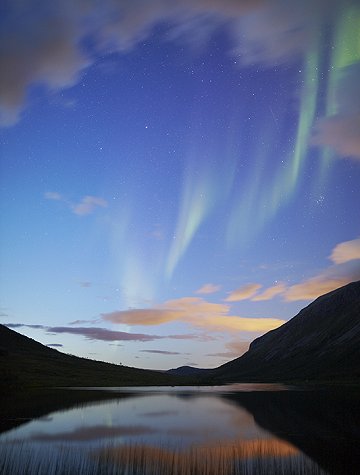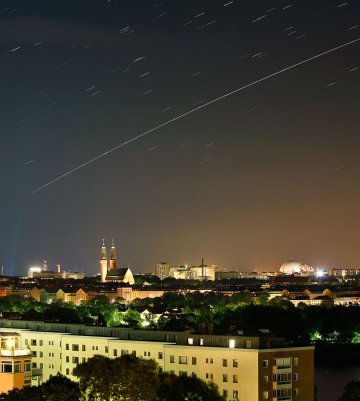| SUNSPOT 1025: A new sunspot emerged yesterday and interrupted a 51-day string of blank suns. It wasn't much of an interruption. Sunspot 1025 is small and may already be fading away. Readers with solar telescopes are encouraged to monitor the situation. AURORA WATCH: On August 30th, a gust of solar wind hit Earth and sparked auroras so bright they were visible in arctic twilight. This is what the sky looked like over Tromso, Norway: 
"What a pleasure to be outdoors on a late-summer evening with a warm breeze and the auroras dancing overhead," says photographer Kjetil Skogli. "I took the picture using a Canon 5D Mark II."
More auroras are in the offing. A solar wind stream is heading for Earth and it could spark a geomagnetic storm when it arrives on Sept. 3rd or 4th. Residents of Alaska, Canada, Iceland and Scandinavia should keep an eye on the sky in the nights ahead. August 2009 Aurora Gallery
[previous Augusts: 2008, 2007, 2006, 2005, 2004, 2003, 2002, 2001] TWO SPACESHIPS: Space shuttle Discovery is docked to the International Space Station (ISS) and, thus joined, the two spaceships are putting on a good show in the night sky. Peter Rosén caught them flying over Stockholm, Sweden, just before sunrise on August 31st: 
"The mission is getting a lot of media coverage here because of our Swedish astronaut Christer Fuglesang," says Rosén. Yesterday, Fuglesang helped unload more than 15,000 lb (Earth weight) of supplies from Discovery's cargo bay. Much of that weight was laboratory equipment. Astronauts are outfitting the space station's science labs with a -80 degree research freezer; a rack of hardware to study crystals and semiconductors in low gravity; and a new set of tools for microgravity fluid physics experiments. NASA says this mission marks an important transition. The space station's "Under Construction" sign is coming down and its world-class science labs are ramping up. That's worth a look. Check the Simple Satellite Tracker for flybys.
Explore the Sunspot Cycle | 
